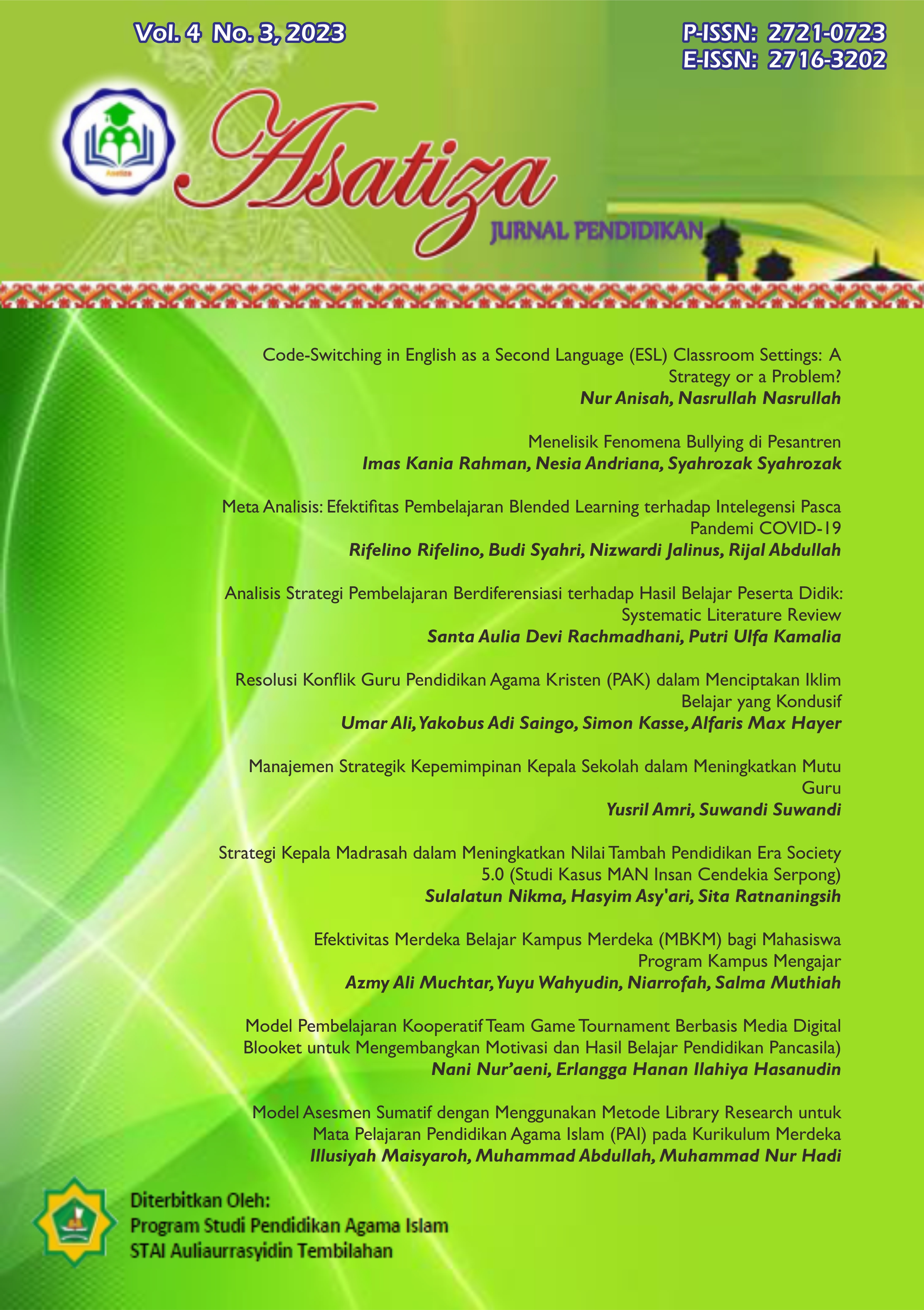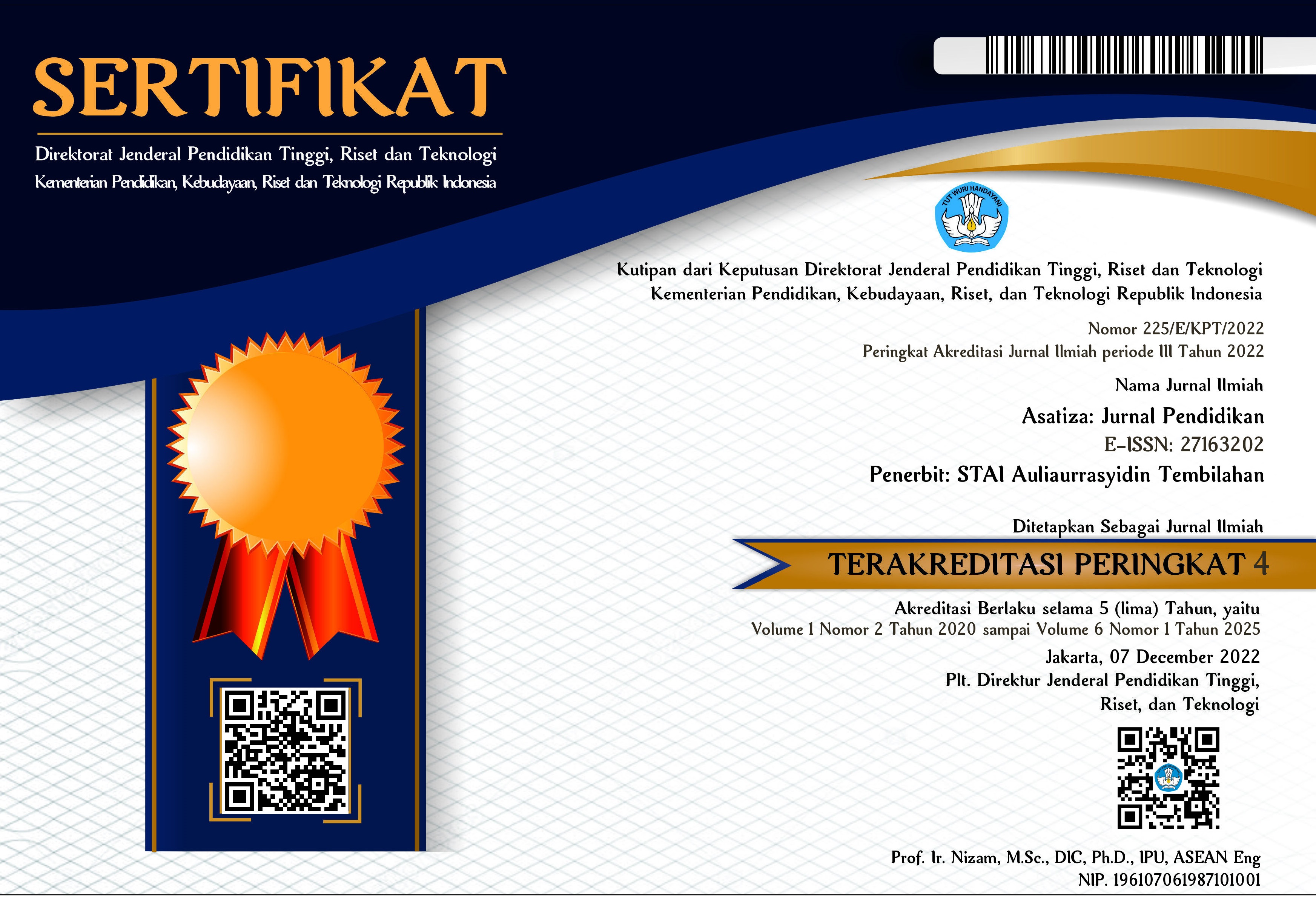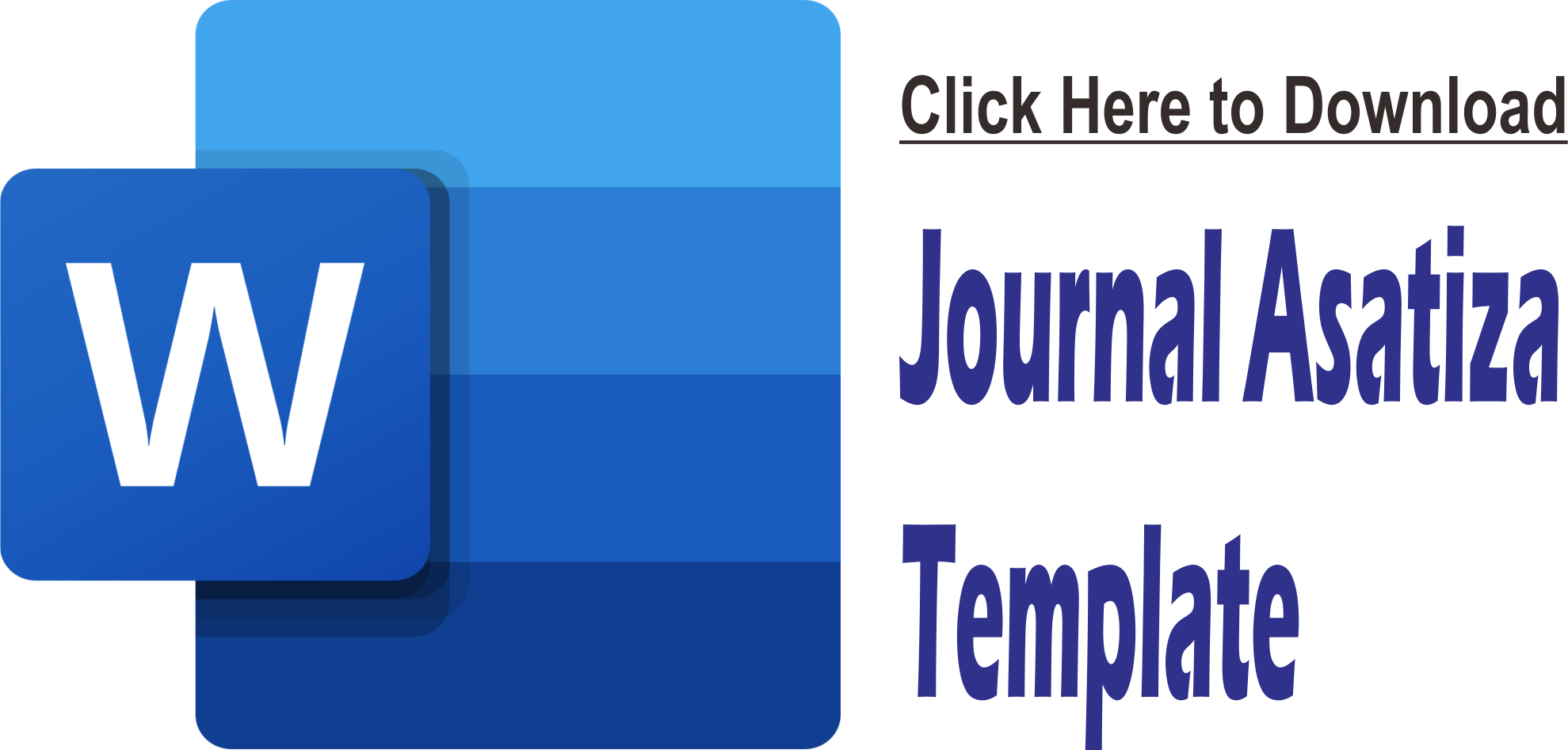Model Asesmen Sumatif dengan Menggunakan Metode Library Research untuk Mata Pelajaran Pendidikan Agama Islam (PAI) pada Kurikulum Merdeka
DOI:
https://doi.org/10.46963/asatiza.v4i3.1063Keywords:
Summative Assessment, PAI Subjects, Independent CurriculumAbstract
The independent curriculum is still relatively new in the learning process, where many teachers are still not able to maximize the process of implementing the independent curriculum, especially in the realm of summative assessment for PAI subjects. The aim of this research is to find out what the summative assessment model for PAI subjects in the Merdeka curriculum is so that teachers can better understand the Merdeka curriculum. This research uses a qualitative approach with a library research method, where in the process of searching for data for this research, references will be used in literature studies. The results of this research are that the summative assessment model for PAI subjects in the independent curriculum has many steps and studies to be implemented. This research produced eight steps in summative assessment in the independent curriculum, namely (1) competency identification; (2) selection of assessment format; (3) assessment instrument specifications; (4) determining the assessment scale; (5) assessment scheduling; (6) the summative assessment is carried out according to schedule; (7) data processing and analysis; and (8) feedback and reporting.
Downloads
References
Adlini, M. N., Dinda, A. H., Yulinda, S., Chotimah, O., & Merliyana, S. J. (2022). Metode penelitian kualitatif studi pustaka. Edumaspul: Jurnal Pendidikan, 6(1), 974-980. https://ummaspul.e-journal.id/maspuljr/article/download/3394/1177/
Ardianti, Yekti, and Nur Amalia. “Kurikulum Merdeka: Pemaknaan Merdeka Dalam Perencanaan Pembelajaran Di Sekolah Dasar.” Jurnal Penelitian dan Pengembangan Pendidikan 6, no. 3 (2022): 399–407. https://ejournal.undiksha.ac.id/index.php/JJL/article/download/55749/24824
Barlian, ujang cepi. “Implementasi Kurikulum Merdeka Dalam Meningkatkan Mutu Pendidikan.” Jurnal of Educational and Language Research 10, no. 1 (2022): 1–52. https://bajangjournal.com/index.php/JOEL/article/download/3015/2154
Barokah, Mabid. “Manajemen Penilaian Sumatif Pada Ranah Kognitif Pembelajaran PAI Kelas X Semester Ganjil Di SMA Negri 2 Pontianak Tahun Pelajaran 2017/ 2018.” Al-Idarah: Jurnal Kependidikan Islam 9, no. 2 (2019): 159–179. http://www.ejournal.radenintan.ac.id/index.php/idaroh/article/viewFile/4859/3250
Elihami, Elihami, and Abdullah Syahid. “Penerapan Pembelajaran Pendidikan Agama Islam Dalam Membentuk Karakter Pribadi Yang Islami.” Edumaspul - Jurnal Pendidikan 2, no. 1 (2018): 79–96. https://ummaspul.e-journal.id/maspuljr/article/download/17/15
Fatha Pringgar, Rizaldy, and Bambang Sujatmiko. “Penelitian Kepustakaan (Library Research) Modul Pembelajaran Berbasis Augmented Reality Pada Pembelajaran Siswa.” Jurnal IT-EDU 05, no. 01 (2020): 317–329. https://ejournal.unesa.ac.id/index.php/it-edu/article/download/37489/33237
Firmansyah, Iman, Mokh. “Pendidikan Agama Islam: Pengertian, Tujuan, Dasar Dan Fungsi.” Jurnal Pendidikan Agama Islam 17, no. 2 (2019): 79–90. https://ejournal.upi.edu/index.php/taklim/article/download/43562/18093
Fitriyah, Chumi Zahroul, and Rizki Putri Wardani. “Paradigma Kurikulum Merdeka Bagi Guru Sekolah Dasar.” Scholaria: Jurnal Pendidikan dan Kebudayaan 12, no. 3 (2022): 237. https://ejournal.uksw.edu/scholaria/article/download/6515/2216
Hanifah, Nunung, Ahmad Zuhdi, and Muhammad Saefullah. “Metode Assesment Guru PAI Terhadap Pengembangan Karakter Moral Keagamaan Siswa SMPN 2 Mojotengah Wonosobo.” JASNA : Journal For Aswaja Studies 2, no. 2 (2022): 1–12. https://scholar.archive.org/work/k5ct3xwyljgmlb4cciad6j52g4/access/wayback/https://ejournal.unisnu.ac.id/j-asna/article/download/3343/pdf
Herman, Asma Ul Husna, and Aisiah. “Analisis Dokumen Kurikulum Pembelajaran Sejarah : Studi Perbandingan Dokumen Kurikulum 2013 Dengan Dokumen Kurikulum Merdeka.” Jurnal Kronologi 4, no. 3 (2022): 242–251. http://kronologi.ppj.unp.ac.id/index.php/jk/article/download/529/281
Homepage, Journal, Pembelajaran PAI Pada Jenjang Madrasah Ibtidaiyah, Ahmad Jaelani, and Program Studi Pendidikan Agama Islam. “Pembelajaran PAI Pada Jenjang Madrasah Ibtidaiyah” (2022): 28–37. https://journal.uniga.ac.id/index.php/JPAI
Jannah, Mumayzizah Miftahul, and Harun Rasyid. “Kurikulum Merdeka : Persepsi Guru Pendidikan Anak Usia Dini” 7, no. 1 (2023): 197–210. https://scholar.archive.org/work/zxffdjlo3fh7hnev3xewcsanm4/access/wayback/https://obsesi.or.id/index.php/obsesi/article/download/3800/pdf
Kemdikbud. “Asesmen Formatif Dan Sumatif.” Www.Guru.Kemdikbud.Go.Id (2020).
labudasari, Erna. rochmah, Eliya. “Pengantar Evaluasi Pembelajaran.” Kemampuan Koneksi Matematis (Tinjauan Terhadap Pendekatan Pembelajaran Savi) 53, no. 9 (2019): 55. https://www.scribd.com/document/489037443/PENGANTAR-EVALUASI-PEMBELAJARAN
Luthfiyah, F. Metode Penelitian Kualitatif (Sistematika Penelitian Kualitatif). Bandung: Rosda Karya, 2020. https://www.academia.edu/9057392/METODE_PENELITIAN_KUALITAIF_Sistematika_Penelitian_Kualitatif
Magdalena, Ina, Annisa Rachmadani, and Mita Aulia. “Penerapan Pembelajaran Dan Penilaian Secara Online Di Masa Pandemi Sdn Karang Tengah 06 Tangerang.” EDISI : Jurnal Edukasi dan Sains 2, no. 2 (2020): 393–409. https://www.ejournal.stitpn.ac.id/index.php/edisi/article/download/1058/742
Majid, Dhea Abdul. “Pembelajaran Pendidikan Agama Islam (Pai) Di Sekolah Berbasis Blended Learning.” Al-Tarbawi Al-Haditsah : Jurnal Pendidikan Islam 4, no. 1 (2019): 178–197. https://www.jurnal.syekhnurjati.ac.id/index.php/tarbawi/article/viewFile/4209/2321
Mujiburrahman, Kartiani, Baiq Sarlita. Pernanda, Lalu. “Pena Anda.” Pendidikan, Jurnal Dasar, Sekolah Merdeka, Dalam Kurikulum 1, no. 1 (2023): 39–48. https://jurnal.ut.ac.id/index.php/penaanda/article/download/5019/1414
Nurul hasanah1, Musa Sembiring2, Khairina Afni3, Risma Dina4, Ice Wirevenska5. “Sosialisasi Kurikulum Merdeka Merdeka Belajar Untuk Meningkatkan Pengetahuan Para Guru Di SD Swasta Muhamaddiyah 04 Binjai.” Ruang Cendikia : Jurnal Pengabdian Kepada Masyarakat 1, no. 3 (2022): 235–238. https://jurnal.arkainstitute.co.id/index.php/ruang-cendekia/article/download/339/260
Rachmawati, Nugraheni, Arita Marini, Maratun Nafiah, and Iis Nurasiah. “Projek Penguatan Profil Pelajar Pancasila Dalam Impelementasi Kurikulum Prototipe Di Sekolah Penggerak Jenjang Sekolah Dasar.” Jurnal Basicedu 6, no. 3 (2022): 3613–3625. https://jbasic.org/index.php/basicedu/article/download/2714/1391
Rodrigo Garcia Motta, Angélica Link, Viviane Aparecida Bussolaro, Geraldo De Nardi Junior, Guida Palmeira, Franklin Riet-Correa, Valéria Moojen, Paulo Michel Roehe, Rudi Weiblen, Jael S. Batista, et al. “Pengembangan Asessment Untuk Mengukur Kemampuan Berpikir Kritis Materi Interaksi Makhluk Hidup Dengan Lingkungan Di Smp Se-Kota Bengkulu.” Pesquisa Veterinaria Brasileira 26, no. 2 (2021): 173–180.
Rokhimah. “Pembelajaran Pendidikan Agama Islam Di Ma’arif NU Langkap.” Jurnal PAI: Jurnal Kajian Pendidikan Agama Islam 1, no. 8.5.2017 (2022): 57. file:///C:/Users/LENOVO%20T420/Documents/bismillah%20alhamdulillah/1078-Article%20Text-1941-1-10-20221228.pdf
Wanti, Adella Ira, Qurrotul A’yuni, and Dewi Chamidah. “Model Dan Praktik: Asesmen Formatif Non Paper-Based Dalam Pembelajaran Bahasa Arab.” Arabi : Journal of Arabic Studies 7, no. 1 (2022): 76–92. https://www.journal.imla.or.id/index.php/arabi/article/download/419/131
Wiguna, I Komang Wahyu, and Made Adi Nugraha Tristaningrat. “Langkah Mempercepat Perkembangan Kurikulum Merdeka Belajar.” Edukasi: Jurnal Pendidikan Dasar 3, no. 1 (2022): 17. http://stahnmpukuturan.ac.id/jurnal/index.php/edukasi/article/view/2296/1741
Downloads
Published
Issue
Section
License
Copyright (c) 2023 Illusiyah Maisyaroh, Muhammad Abdullah, Muhammad Nur Hadi

This work is licensed under a Creative Commons Attribution-ShareAlike 4.0 International License.
Authors who publish with this journal agree to the following terms:
1. Copyright on any article is retained by the author(s).
2. The author grants the journal, right of first publication with the work simultaneously licensed under a Creative Commons Attribution shareAlike 4.0 International License that allows others to share the work with an acknowledgment of the work’s authorship and initial publication in this journal.
3. Authors are able to enter into separate, additional contractual arrangements for the non-exclusive distribution of the journal’s published version of the work (e.g., post it to an institutional repository or publish it in a book), with an acknowledgment of its initial publication in this journal.
4. Authors are permitted and encouraged to post their work online (e.g., in institutional repositories or on their website) prior to and during the submission process, as it can lead to productive exchanges, as well as earlier and greater citation of published work.
5. The article and any associated published material is distributed under the Creative Commons Attribution-ShareAlike 4.0 International License











2.png)



